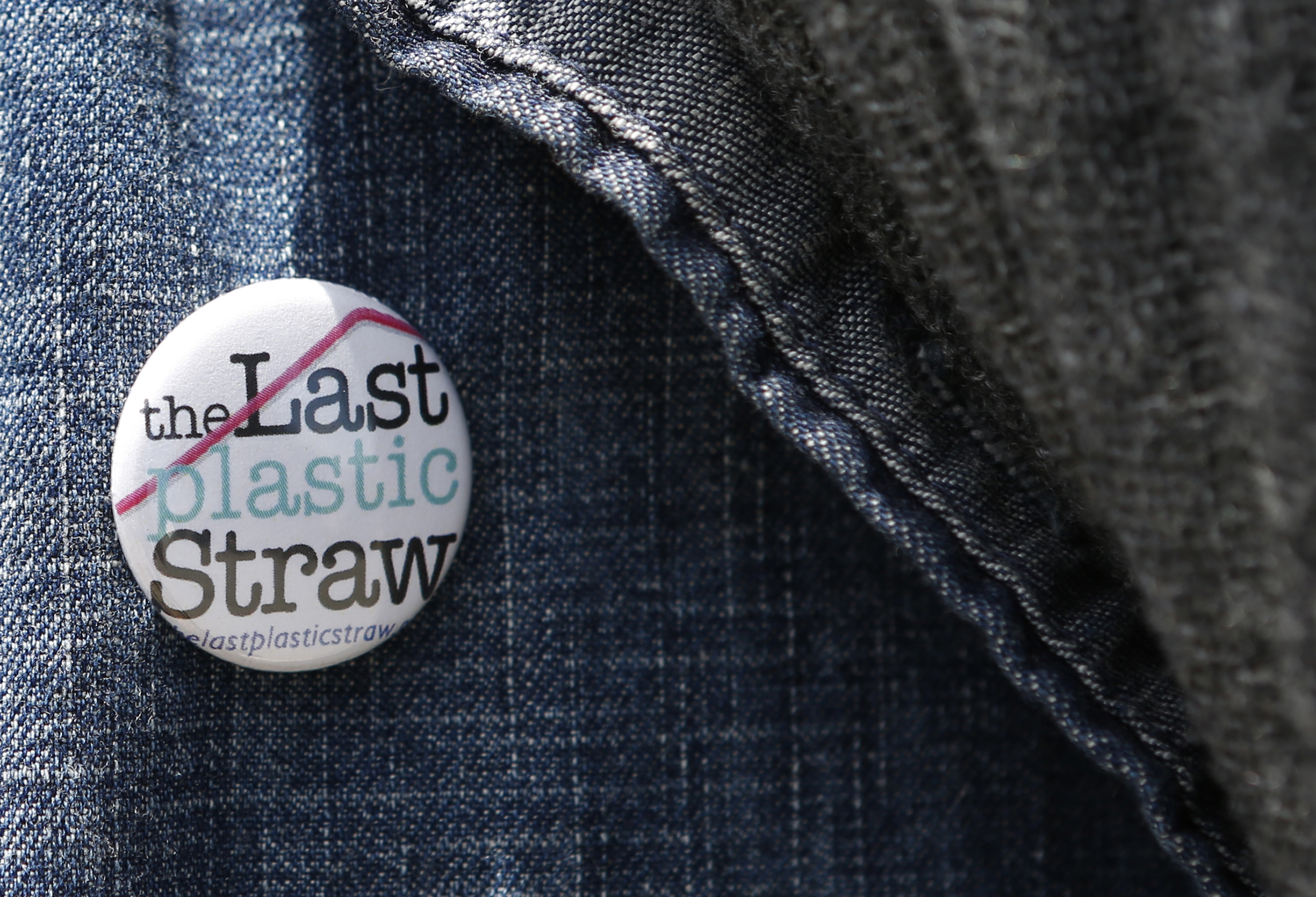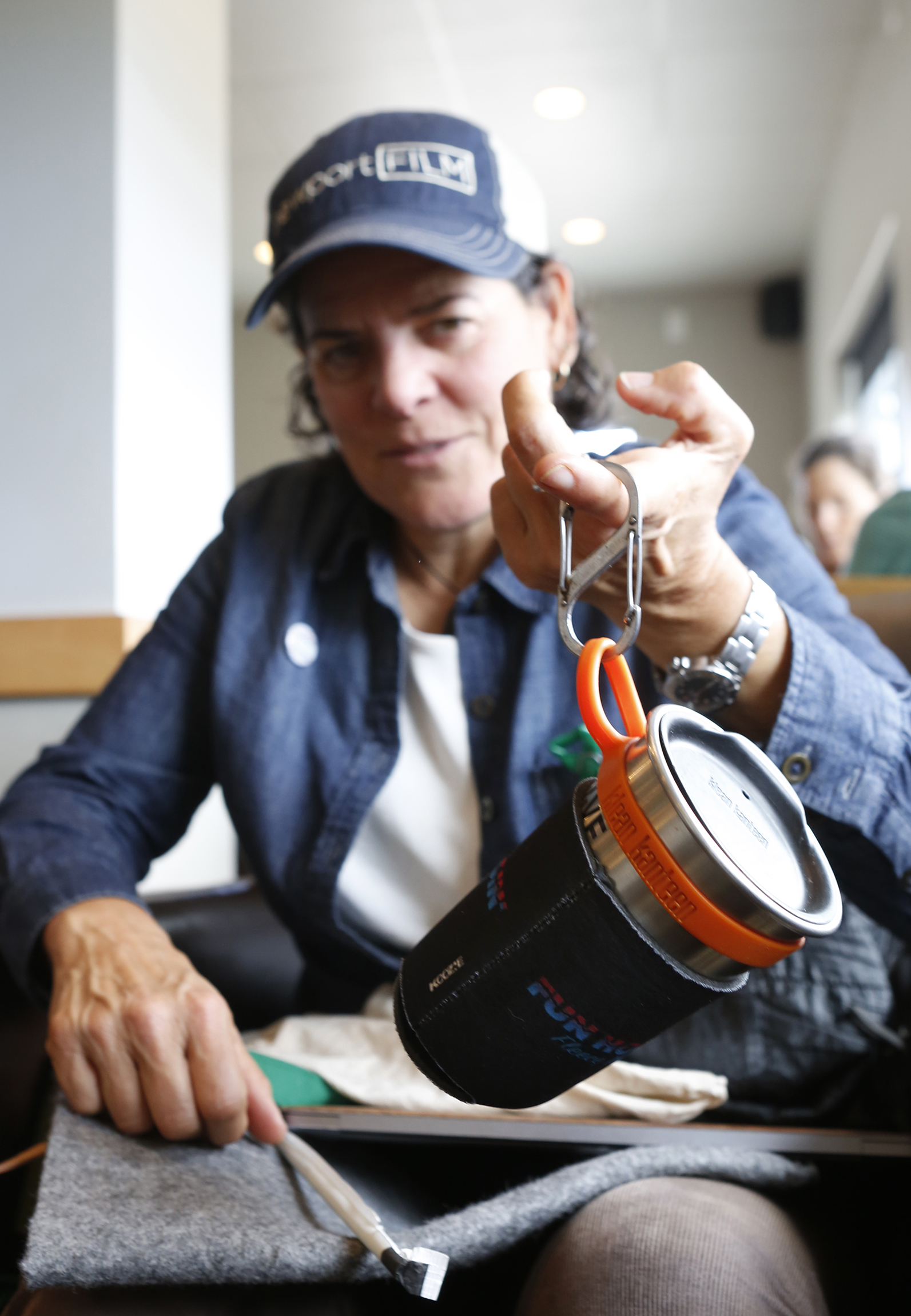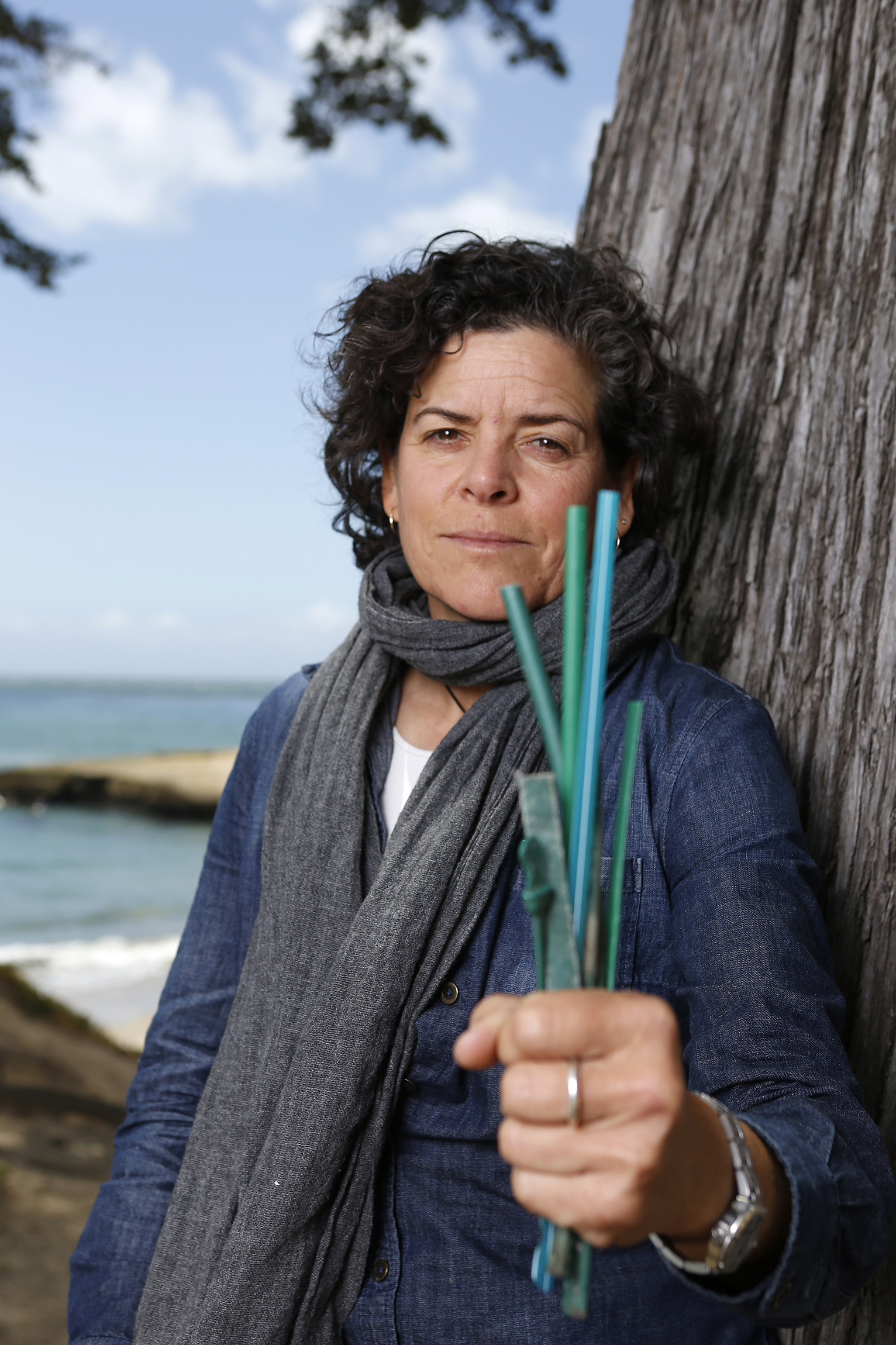By Kathryn McKenzie
Photos by David Royal
Jackie Nunez is on a mission. After double-locking her bike outside the Sunny Cove Starbucks on the east side of Santa Cruz, she investigates the ground for single-use plastics — and finds more than she’d like to see there.
“This is what I’m talking about,” Nunez said, stabbing a finger earthward, toward lids, cups and, especially, drinking straws, which are scattered along the edges of the Starbucks parking lot and lodged in bayside crevices, just a few steps away from the ocean.
Nunez, a kayak and river guide, has made it her life’s work to eliminate as many single-use plastics from the environment as possible. Seven years ago, she established The Last Plastic Straw, first as a Facebook page and later as its own organization, and it’s now part of the worldwide Plastic Pollution Coalition.
Her own “last plastic straw” moment came after leading a kayak trip in Belize where a fierce storm washed plastic debris into a pristine coastal area: “It was literally a river of trash going by,” said Nunez. On returning to Santa Cruz, she went out with friends to a bar and asked for a glass of water.
When her glass came — with a plastic straw in it that she hadn’t asked for — she realized that she had to do something.
Nowadays, anti-straw activism is hot, and it could be argued that Nunez has helped make Santa Cruz a hub of the movement. She’s worked with a wide variety of organizations, most notably Save Our Shores and Surfrider locally, and has consulted with and informed numerous others. She has become the face of the movement, especially since being prominently featured in the 2017 eco-documentary “Straws.”
“Straws” director Linda Booker wrote via email that when she went looking for an activist to feature in her film, Nunez popped up in her research.
“At that time there were few people in the U.S. who had campaigns (boy, has that ever changed now!) and Jackie was one of them who started her advocacy against plastic straws in 2011,” said Booker.
Nunez has been working tirelessly, and mostly on her own dime, during that time. (Just recently, she was hired full-time by the Plastic Pollution Coalition.) She talks to schools, organizations, city councils, and anyone else who’ll listen, and often appears at screenings of “Straws,” most recently in Washington D.C.
She reels off facts and figures about the plastic problem with few pauses and no frivolity. Sitting inside Starbucks, she is critical of the company, and of this store in particular.
“This is a riparian zone,” she said, a referring to the nearby waterway that leads to the ocean, and so it’s particularly alarming that plastic trash accumulates here and can easily be swept out to sea by wind and water. “This area should be mandated green business certified.”

Straws as a gateway issue
In the beginning, Nunez was one of the few taking up the anti-straw banner. Now, there’s a tide rising against plastic straws as well as other one-time-only plastics, as evidenced by a wide variety of campaigns and projects like Straws Suck and Straw Wars.
Why focus on straws, when there are so many other types of single-use plastic that are part of the problem? “Straws are a gateway issue,” said Nunez, and they are particularly egregious because of the short time they’re used and their persistence in the environment.
But the impact from the anti-straw movement is real, and it’s becoming law. In California, a state bill to prevent restaurants from giving out plastic straws except by patron request is moving forward to a Senate vote. Seattle is about to go strawless, and even New York City is considering a ban.
Worldwide, entire countries are giving up the plastic habit, most notably the United Kingdom, which will prohibit a variety of single-use plastics over the next two years, including straws.
Businesses are also taking notice of the movement. Bon Appétit, a nationwide food service company, announced last week it was phasing plastic straws out immediately at more than 1,000 locations. The company operates the café at the Monterey Bay Aquarium, which last year announced it would eliminate single-use plastics, along with other aquariums across the country.
Locally, there’s also plenty of concern on the issue. The city and county of Santa Cruz outlawed single-use plastic items for food service last year, Carmel banned plastic utensils and straws in April, and the city of Monterey is also considering similar regulations.
Nunez is particularly dismayed that this Starbucks, which was serving drinks with paper straws a few months ago, has returned to “compostable” straws. The compostables are similar to plastic and made from plant products, but don’t break down naturally in the environment. To do so takes a special high-heat commercial facility. “Once in the ocean, they behave like plastics,” she said. They could be around a very long time doing damage to sea life.
She goes on fighting the battle, first talking to a manager inside the coffee establishment, and later collecting handfuls of trash on the short walk to the beach.

The straw conundrum
Most people, unless very young or disabled, don’t need to use a straw, but there’s a certain segment of the population that just really, really likes straws. Kim Solano is one of them. The owner and chef of the Haute Enchilada in Moss Landing, Solano says she gets why people are reluctant to give them up.
“I enjoy drinking out of a straw,” she said. But after Nunez educated her about the impact of plastic straws on the environment, Solano carries a reusable stainless steel version with her. Since 2014, her restaurant has been free of both plastic straws and plastic drink stirrers.
Although Solano always considered herself ecologically minded, she admits she didn’t realize the impact of plastic straws until a chance meeting with Nunez while kayaking. Part of Nunez’s advocacy has been convincing restaurant owners to offer straws only on request, or to offer only paper straws. Restaurants who make the switch are listed on The Last Plastic Straw website.
A single plastic straw — so slight and slim — seems harmless enough. It’s fun and it’s convenient. Yet our collective straw habit adds up to an enormous environmental impact, and added to the other plastics we dispose of each day, adds up to hundreds of tons each day. And plastic never really goes away — jamming our oceans with enormous rafts of debris that has nowhere else to go.
Ocean creatures mistake plastic items for food and eat them; a viral YouTube video in 2016 showing the removal of a straw from a sea turtle’s nose dramatically shows that all it takes is one to injure wildlife. (“The turtle video really blew it up,” said Nunez of the anti-straw movement. “That was a lot of people’s last plastic straw moment.”)
In a perfect world, all plastic straws would be disposed of properly and would not escape into the environment. But people drop them on the ground, or they blow out of trash bins and garbage trucks, and eventually find their way into waterways. One figure that’s long been used is that 500 million plastic straws are used each day in the United States. Some people think this estimate is too low.
A plastic straw is used for a few moments and then thrown away, but “it will outlive me and generations to come,” said Nunez.
If all straws were made from paper, this wouldn’t be a problem — paper straws break down quickly once exposed to the elements. But this is exactly why some people don’t like them, Solano said. After the Haute Enchilada made the switch to paper straws, her customers didn’t complain, but at the adjacent Whole Enchilada restaurant, “They (the customers) bitched like crazy … they didn’t like that the straws got soft and soggy.”
Paper straws are also more expensive, but as Solano points out, the costs decrease if restaurants only offer them on request. “We’re only probably giving out a tenth of the straws that we used to,” she said.
Still, it’s not impossible to change people’s habits, as evidenced by California’s single-use plastic bag ban. Studies are now showing that plastic bag litter on beaches has dropped by 72 percent since 2010. This holds out hope for reducing other types of plastic debris by legislation.

An education on true cost of plastics
But a change also has to be made in the way that we view anything made to be thrown away. Sure, plastic utensils are cheap up front, but consider the true cost.
Refusing single-use plastic is the key, Nunez says, and opens her backpack to reveal her own kits for eating and taking food along. She carries a variety of reusable straws with her (“I’m a straw geek”) as well as her own sturdy bottles, cloth napkins and dining ware, which she uses while on the road and on her river guide excursions. Refusing disposable plastics is always easier when you carry your own gear.
Reusable straws are now widely available in a variety of materials, and biodegradable straws are also experiencing a renaissance — not just paper, but also made from bamboo or rye grass. There’s even a new edible straw by Loliware, introduced last year and made from a seaweed-based material.
It isn’t just Nunez leading the charge to educate the public. Save Our Shores, which leads regular beach cleanups around Monterey Bay, also coaches some 5,000 students a year on plastic pollution, through school field trips, classroom education programs, and youth group activities.
“Straws are always part of the solution conversation because they are so easy to pledge to eliminate,” said Tucker Hirsch, SOS programs manager. “We encourage students to change their behavior to eliminate single-use plastics, like straws, but we also ask them what they can do to encourage others in their life to follow suit.”
People have long been urged to reduce, reuse and recycle, and this first R is the most important, Hirsch said. “Straws are something that should be easy to reduce: just say no to straws or bring your own.”
Nunez wears a plastic straw, bent into a curved ribbon, on her shirt as reminder to refuse single-use plastics. “We’re at a stage where we need to grow up and take responsibility for our trash,” she said. “We can’t just ship it off anymore … the systems we have in place are not working.”
She’s urging people to challenge themselves through Plastic Free July, a month-long pledge to refuse single-use plastics. And at the very least, she said, people should take part in beach cleanups — “it’s our first line of defense.”
And though so much has already been accomplished in the anti-plastic movement, Nunez said, “I’m not done yet.”
Have something to say about this story? Send us a letter.